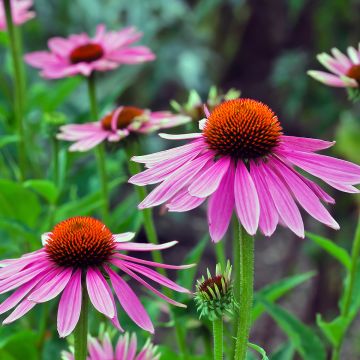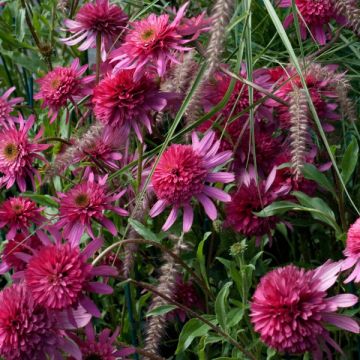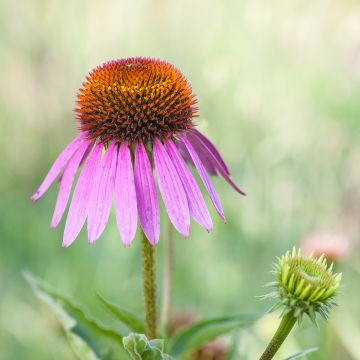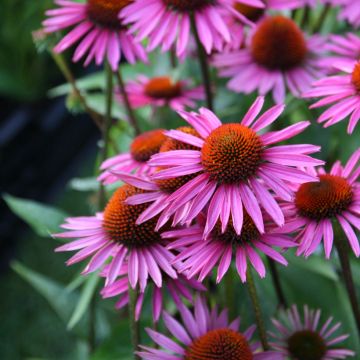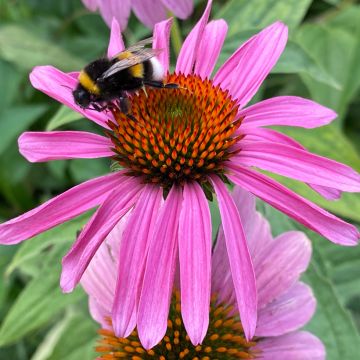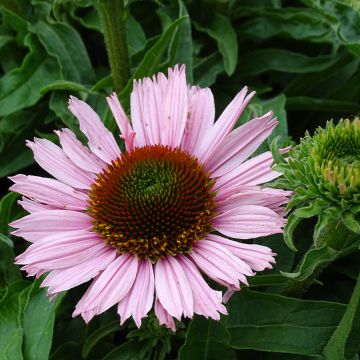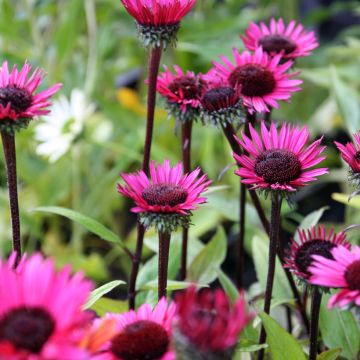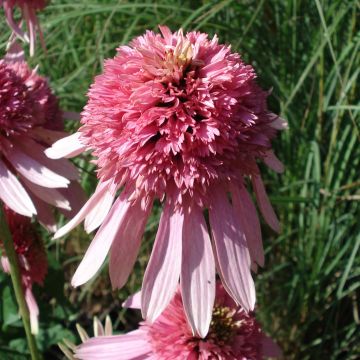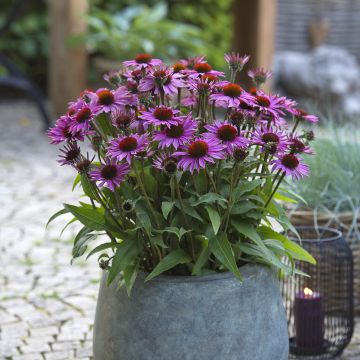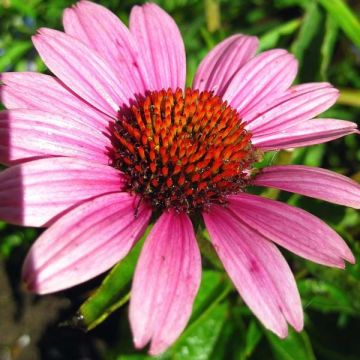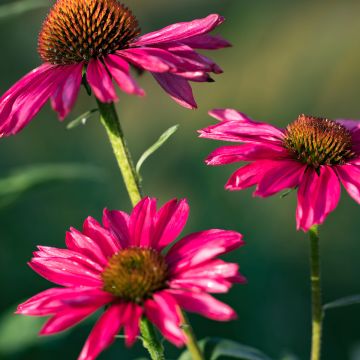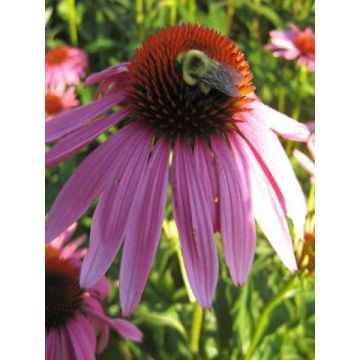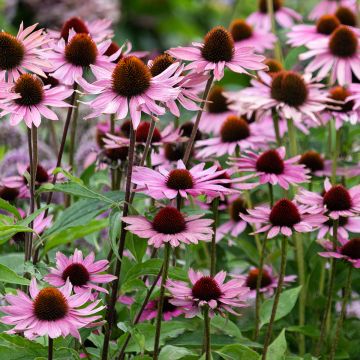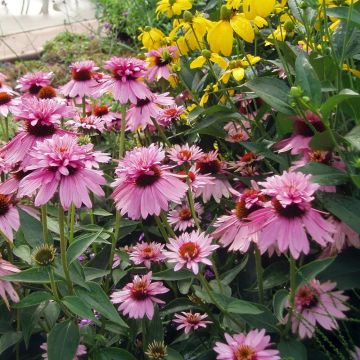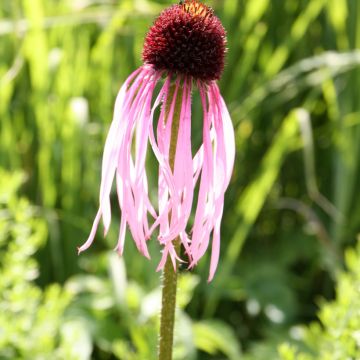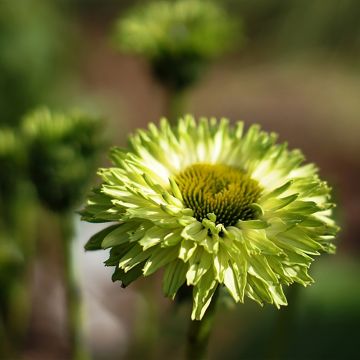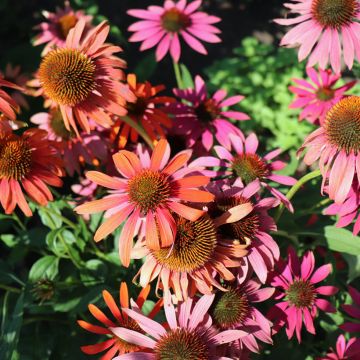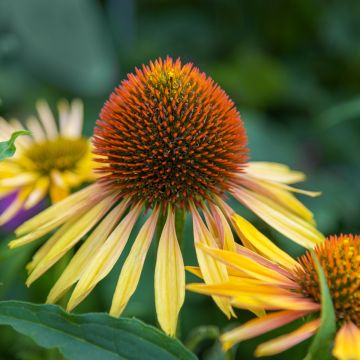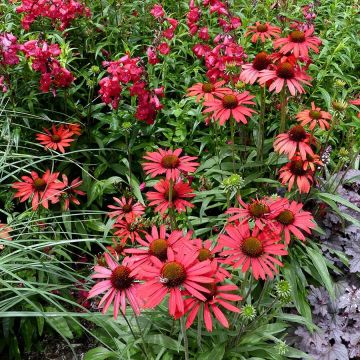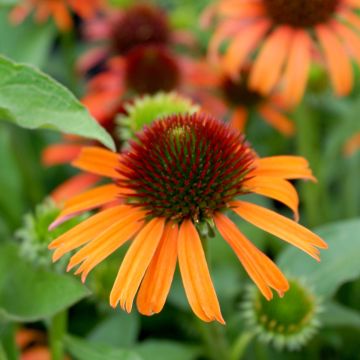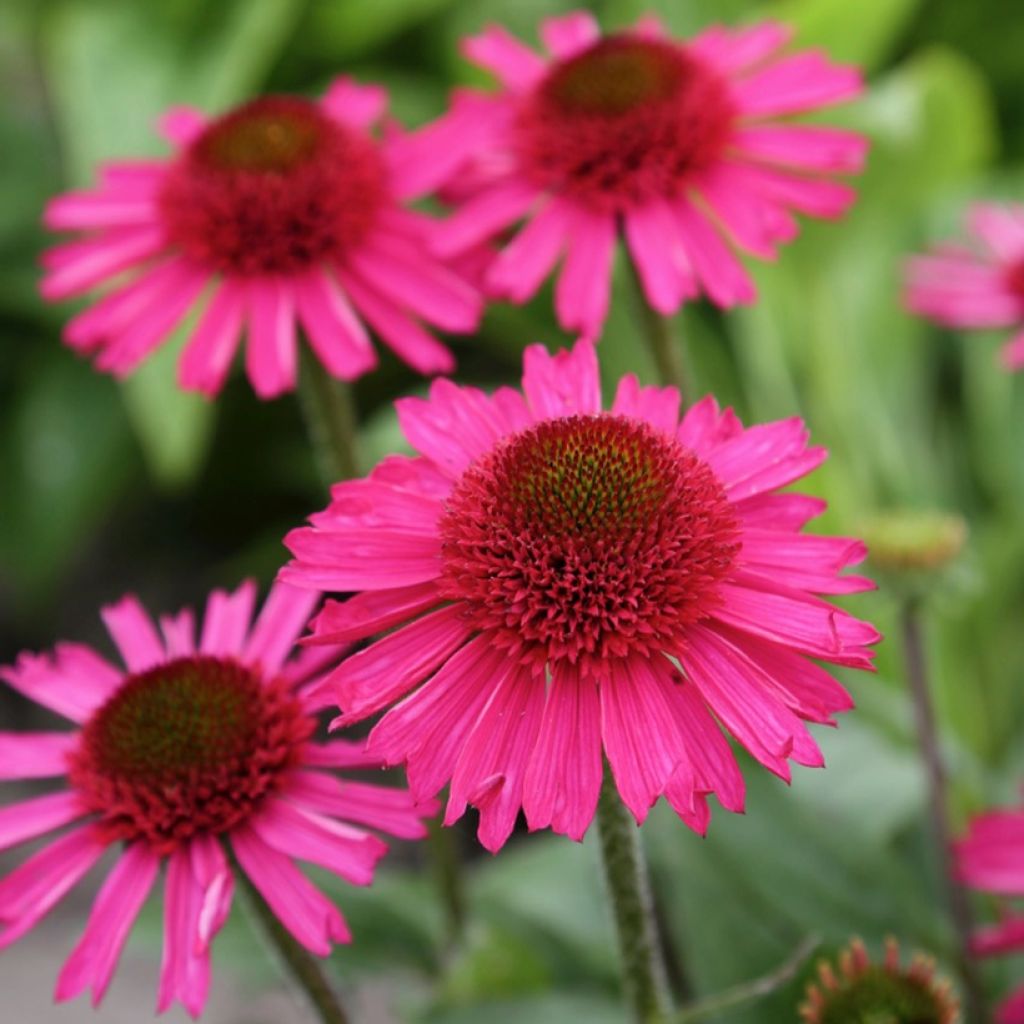

Echinacea purpurea Delicious Candy - Purple coneflower
Echinacea purpurea Delicious Candy - Purple coneflower
Echinacea purpurea Delicious Candy
Eastern purple coneflower, Purple coneflower
Why not try an alternative variety in stock?
View all →This plant carries a 12 months recovery warranty
More information
We guarantee the quality of our plants for a full growing cycle, and will replace at our expense any plant that fails to recover under normal climatic and planting conditions.
From €5.90 for pickup delivery and €6.90 for home delivery
Express home delivery from €8.90.
From €5.90 for pickup delivery and €6.90 for home delivery
Express home delivery from €8.90.
Does this plant fit my garden?
Set up your Plantfit profile →
Description
The 'Delicious Candy' Echinacea is a variety of Echinacea that combines many qualities. It is an exceptionally floriferous selection, vividly pink in colour, with compact and vigorous vegetation. Easy to grow in regular soil, this perennial is covered in flowers from mid to late summer. Invite it into your sunny flower beds and large borders! And create beautiful bouquets with its fresh or dried flowers.
The 'Delicious Candy' Echinacea x purpurea belongs to the Asteraceae family. This cultivar is the result of cross-breeding different species native to North American prairies. This variety has strong, ramified stems and a dense clumping habit, reaching 60cm in height and 40cm in width. This plant doesn't weaken or collapse, demonstrating very good stability. Its lanceolate, green, oppositely arranged leaves are covered in rough hairs. 'Delicious Candy' has one of the earliest flowering periods among Echinaceas. It starts in July, earlier or later depending on the climate, and continues until the end of summer. The plant produces a great number of flowers that are highly visited by butterflies. The ramified, greenish-red inflorescence terminates in a solitary 5-6cm in diameter head, with a prominent disc and tiny magenta rose florets resembling a pompom. This large heart is surrounded by a double row of ligules or horizontal petals in fuchsia pink. The fruit is an achene releasing seeds that birds love. This plant firmly and deeply anchors itself in the soil with its well-developed root system. Its above-ground vegetation, deciduous, emerges in spring and dries out in autumn.
The 'Delicious Candy' Echinacea is a remarkable border plant, especially for its generous and vibrant flowering. This Echinacea can be planted mixed with other flowers in shades of pink, white, mauve, or even lavender blue, with contrasting forms (beebalms, bushy salvias, lavenders, panicle phlox, carnations). It also pairs well with yarrows, daisies, and summer asters. The intense pink colour of the 'Delicious Candy' Echinacea is also beautiful in fresh or dried flower bouquets.
The scent of Echinacea varies depending on the stage of flowering. Initially, when the florets are in an upright crown, the scent is barely noticeable. At full bloom, when the florets droop as if drained of their strength, it exhales a delicate honey scent that is very attractive to bees, butterflies, and other insects. Once the head is pollinated, the scent takes on a more vanilla note.
Benefits: In homeopathy, its root is used to fight against colds and to strengthen the immune system. These properties were already used by Native Americans. The name Echinacea comes from the Greek word echinos, which means "hedgehog-like," and acea, meaning "having the form of," alluding to the flower heads. Purpurea means "purple."
Report an error about the product description
Flowering
Foliage
Plant habit
Botanical data
Echinacea
purpurea
Delicious Candy
Asteraceae
Eastern purple coneflower, Purple coneflower
Cultivar or hybrid
Other Echinacea - Coneflower
Planting and care
Echinacea hybrids are highly cold-resistant and easy to grow in any moist, well-drained soil. This plant takes its time to establish itself; indeed, its growth is rather slow. But in return, once in place, it requires no special care and is highly resistant to pests and diseases. It is preferably planted in spring, in a sunny location, in a mixture of potting soil and well-drained garden soil. The soil must be deep and loose to accommodate its root system. Add compost in spring and water in summer if it is very dry. Remove faded flowers as they appear. Divide the clump when flowering slows down. It is a plant with rhizomes that can become invasive if it likes its surroundings. As the plant ages, it becomes more susceptible to aphid attacks and powdery mildew. Mulch the base in May to retain moisture in summer, as it is sensitive to water shortage during the flowering period.
Planting period
Intended location
Care
This item has not been reviewed yet - be the first to leave a review about it.
Haven't found what you were looking for?
Hardiness is the lowest winter temperature a plant can endure without suffering serious damage or even dying. However, hardiness is affected by location (a sheltered area, such as a patio), protection (winter cover) and soil type (hardiness is improved by well-drained soil).

Photo Sharing Terms & Conditions
In order to encourage gardeners to interact and share their experiences, Promesse de fleurs offers various media enabling content to be uploaded onto its Site - in particular via the ‘Photo sharing’ module.
The User agrees to refrain from:
- Posting any content that is illegal, prejudicial, insulting, racist, inciteful to hatred, revisionist, contrary to public decency, that infringes on privacy or on the privacy rights of third parties, in particular the publicity rights of persons and goods, intellectual property rights, or the right to privacy.
- Submitting content on behalf of a third party;
- Impersonate the identity of a third party and/or publish any personal information about a third party;
In general, the User undertakes to refrain from any unethical behaviour.
All Content (in particular text, comments, files, images, photos, videos, creative works, etc.), which may be subject to property or intellectual property rights, image or other private rights, shall remain the property of the User, subject to the limited rights granted by the terms of the licence granted by Promesse de fleurs as stated below. Users are at liberty to publish or not to publish such Content on the Site, notably via the ‘Photo Sharing’ facility, and accept that this Content shall be made public and freely accessible, notably on the Internet.
Users further acknowledge, undertake to have ,and guarantee that they hold all necessary rights and permissions to publish such material on the Site, in particular with regard to the legislation in force pertaining to any privacy, property, intellectual property, image, or contractual rights, or rights of any other nature. By publishing such Content on the Site, Users acknowledge accepting full liability as publishers of the Content within the meaning of the law, and grant Promesse de fleurs, free of charge, an inclusive, worldwide licence for the said Content for the entire duration of its publication, including all reproduction, representation, up/downloading, displaying, performing, transmission, and storage rights.
Users also grant permission for their name to be linked to the Content and accept that this link may not always be made available.
By engaging in posting material, Users consent to their Content becoming automatically accessible on the Internet, in particular on other sites and/or blogs and/or web pages of the Promesse de fleurs site, including in particular social pages and the Promesse de fleurs catalogue.
Users may secure the removal of entrusted content free of charge by issuing a simple request via our contact form.
The flowering period indicated on our website applies to countries and regions located in USDA zone 8 (France, the United Kingdom, Ireland, the Netherlands, etc.)
It will vary according to where you live:
- In zones 9 to 10 (Italy, Spain, Greece, etc.), flowering will occur about 2 to 4 weeks earlier.
- In zones 6 to 7 (Germany, Poland, Slovenia, and lower mountainous regions), flowering will be delayed by 2 to 3 weeks.
- In zone 5 (Central Europe, Scandinavia), blooming will be delayed by 3 to 5 weeks.
In temperate climates, pruning of spring-flowering shrubs (forsythia, spireas, etc.) should be done just after flowering.
Pruning of summer-flowering shrubs (Indian Lilac, Perovskia, etc.) can be done in winter or spring.
In cold regions as well as with frost-sensitive plants, avoid pruning too early when severe frosts may still occur.
The planting period indicated on our website applies to countries and regions located in USDA zone 8 (France, United Kingdom, Ireland, Netherlands).
It will vary according to where you live:
- In Mediterranean zones (Marseille, Madrid, Milan, etc.), autumn and winter are the best planting periods.
- In continental zones (Strasbourg, Munich, Vienna, etc.), delay planting by 2 to 3 weeks in spring and bring it forward by 2 to 4 weeks in autumn.
- In mountainous regions (the Alps, Pyrenees, Carpathians, etc.), it is best to plant in late spring (May-June) or late summer (August-September).
The harvesting period indicated on our website applies to countries and regions in USDA zone 8 (France, England, Ireland, the Netherlands).
In colder areas (Scandinavia, Poland, Austria...) fruit and vegetable harvests are likely to be delayed by 3-4 weeks.
In warmer areas (Italy, Spain, Greece, etc.), harvesting will probably take place earlier, depending on weather conditions.
The sowing periods indicated on our website apply to countries and regions within USDA Zone 8 (France, UK, Ireland, Netherlands).
In colder areas (Scandinavia, Poland, Austria...), delay any outdoor sowing by 3-4 weeks, or sow under glass.
In warmer climes (Italy, Spain, Greece, etc.), bring outdoor sowing forward by a few weeks.

































